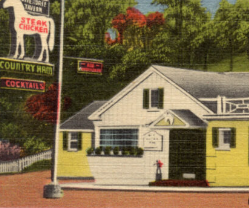Dr. Paul A. Tenkotte
Special article from NKyTribune
Part 1 of an occasional series on casual and fine dining
Located just outside the Covington city limits in Park Hills, White Horse Tavern is a dining experience offering the Cincinnati/Northern Kentucky area. Located at 1501 Dixie Highway (US 25/42), White Horse was one of more than a dozen restaurants along what was once known as the “Gourmet Strip.”
Other restaurants and clubs along the “Gourmet Strip” included Marshall’s (Park Hills), Golden Goose (Park Hills), Town and Country (Park Hills), Lookout House (Fort Wright), Oelzner’s Colonial Tavern (Fort Wright), Hofbrauhaus (formerly Foltz, Fort Wright), Hearthstone (Fort Mitchell), Greyhound Grill (Fort Mitchell), Letschulte’s Five Mile House (Lakeside Park), Cabana Club (Erlanger), Colonial Cottage (Erlanger), Dock’s Place (Ellesmere), The Swan (Ellesmere), and Southern Trails (Florence).
Opened in 1936 during the Great Depression, the White Horse Tavern was the first restaurant on the geographic “foodie strip” that runs south from Covington along Dixie Highway. Its founder was Ben S. Castleman Sr. The restaurant began with one small dining room and an outdoor gas pump. Over the next 22 years, Castleman renovated or expanded the restaurant nine times, and in 1956 he added the “Keeneland Wing,” which could seat 200 diners.
 The White Horse Tavern circa 1948, prior to the 1956 “Keeneland” addition. (From a postcard in the collection of Paul A. Tenkotte)
The White Horse Tavern circa 1948, prior to the 1956 “Keeneland” addition. (From a postcard in the collection of Paul A. Tenkotte)
By 1958, the White Horse employed 20 people in the kitchen, 25 servers and hosts, and four bartenders. It was known throughout the region for its delicious food, including steaks, chops, fresh Maine lobster, country ham, and fried chicken. The atmosphere was cozy and inviting, with a fireplace, knotty pine paneling, and numerous photos of famous racetracks and American thoroughbred horses. The restaurant opened at 11:00 a.m. every day and closed at 1:00 a.m. on weekdays and 2:00 a.m. on weekends.
Ben Castleman Sr. loved horses and horse racing. He owned a farm in Lexington where he bred horses. Historian James C. Claypool recalls: “Castleman tried to sell a horse at Keeneland for $15,000 a head, but couldn’t get it. He got a call from a veterinarian named Hill, who represented a horse owner in Seattle. They offered $17,500 for the horse, and Castleman accepted. The horse, named Seattle Slew by the new owner, won the Triple Crown in 1977 and was undefeated in the Triple Crown races. Castleman then sold the broodmare that produced Seattle Slew for $250,000.”
On the evening of Wednesday, January 26, 1972, a fire broke out at the White Horse Tavern. All employees and customers escaped safely. Caused by faulty wiring, the blaze completely destroyed the restaurant. Castleman temporarily relocated to the old Golden Goose restaurant across the street, but closed in September 1972.
 The White Horse Tavern after the addition on the right in 1956. (From a postcard in the collection of Paul A. Tenkotte)
The White Horse Tavern after the addition on the right in 1956. (From a postcard in the collection of Paul A. Tenkotte)
In October 1977, Ben Castleman reopened the White Horse at 3041 Dixie Highway in Edgewood’s Heritage International Shopping Center, but the new White Horse was unable to turn business around and closed less than a year later, in June 1978. Ben Castleman Sr. passed away in April 1983. He is buried in Highland Cemetery in Fort Mitchell.
But parts of the old White Horse Tavern live on: You can still see the iconic white horse statue that stood outside the old restaurant at the Bellinger Crawford Museum in Covington’s Devoe Park.
Dr. Paul A. Tenkotte is a professor of history and gender studies at Northern Kentucky University (NKU) and editor of the weekly series “Our Rich History.” He can be reached at tenkottep@nku.edu. Dr. Tenkotte is also co-director of the ORVILLE Project (Ohio River Valley Innovation Library and Learning Enhancement Project). For more information, visit https://orvillelearning.org/.


